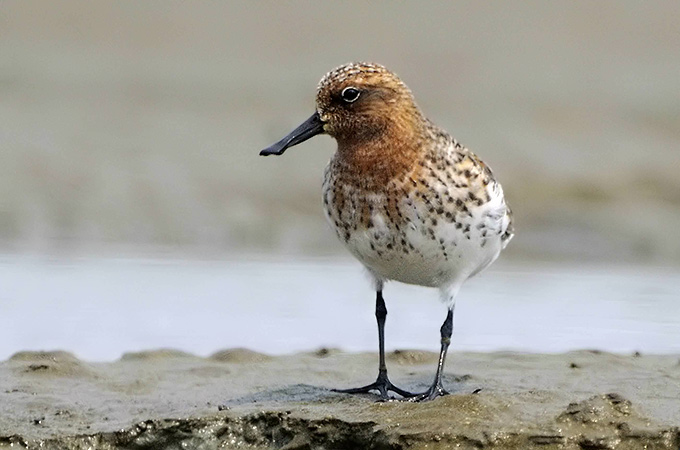The Spoon-billed Sandpiper Eurynorynchus pygmeus is a charismatic species of intertidal wetlands. Due to reclamation and other threats the species has declined rapidly, and the global population now numbers only a few hundred individuals. Once found in flocks of "several hundred" in the Nakdong Estuary and of 180-280 in the Saemangeum Estuarine System, it is the only regularly-occurring Critically Endangered bird species in the Republic of Korea (ROK). It is likely to become globally extinct in the wild within a decade unless improved conservation action is taken.
In recognition of this, the Spoon-billed Sandpiper is part of Birds Korea's banner, and has been at the core of our work since our foundation in late 2004. We have been the ROK representative of the international Spoon-billed Sandpiper Task Force since 2006, and we have responsibility for collating Korean records of the species and for helping to develop a domestic conservation strategy.
Within the ROK, our work for the Spoon-billed Sandpiper and its habitat has included the Saemangeum Shorebird Monitoring Program (SSMP). This three-year long program was conducted in partnership with the Australasian Wader Studies Group between 2006 and 2008, and was the first major collaborative program of its kind in the ROK. It was also the first research in Asia that measured the impacts of a large-scale reclamation project on migratory shorebirds at the site, the national and the global level.

© Kim Hyangee
The SSMP covered the Saemangeum Estuarine System (the most important known site in the world in the 1990s for staging Spoon-billed Sandpiper), the Geum Estuary and Gomso Bay, and also included a nationwide shorebird survey. We published the SSMP results online, in bilingual reports, and in the scientific literature, and we have reported them at national and international meetings and to media. The SSMP supported the conservation efforts of local stakeholders and national decision-makers. It thus contributed to the cancellation of the reclamation of the Geum Estuary (the nation's most important remaining site for Spoon-billed Sandpiper) and to the improved conservation status of Gomso Bay (now in-part a Ramsar site, supporting a maximum of four Spoon-billed Sandpiper in 2010). Our work for Saemangeum also continues. We counted shorebirds within the Saemangeum reclamation area in 2010 and 2011, finding there five Spoon-billed Sandpiper (1% or more of the world population) as recently as September 2011. We also conducted preliminary research on Spoon-billed Sandpiper feeding ecology at Saemangeum and in the Nakdong Estuary, the Geum Estuary and Gomso Bay in October 2011 - video-recording feeding birds, and collecting mud and sand samples in areas used by the species. This is the first such detailed feeding study on Spoon-billed Sandpiper that we are aware of, anywhere within its range.
How will Birds Korea help the Spoon-billed Sandpiper into the future
In 2012, as our capacity allows, we aim;
To conduct more detailed research on Spoon-billed Sandpiper feeding ecology;
To support the development of an improved restoration plan in Gomso Bay;
To work towards restoring tidal-exchange and maintaining habitat within the Saemangeum Reclamation Area;
To produce more Public Awareness materials, focused on Spoon-billed Sandpiper habitat and introducing international conservation initiatives to local and regional stakeholders;
To work, publicly and behind-the-scenes, in support of initiatives that can improve consensus on ways to achieve the conservation of the Yellow Sea's intertidal wetland. This includes active participation in the IUCN World Conservation Congress, to be held in the ROK in September 2012.

Adult, Simpo, April 2008. © Richard Chandler
We can help the Spoon-billed Sandpiper - with your support
Thanks to the support that we have received since 2004, Birds Korea has already done much for the Spoon-billed Sandpiper and for the tidal-flats the species depends on. Our work has been well-covered by media, and has been recognised both by Civil Society (Birds Korea was recognised as a "Leading Light of Korean Society" in 2008) and through our winning the 17th Annual Asian Environment Award in October 2011 (hosted by the Chosun Ilbo and Mainichi newspapers).
Birds Korea can help the Spoon-billed Sandpiper.
Please support us: your membership, donations, advice and participation really do make a difference!
With greater financial and technical support we can build on our work for the Spoon-billed Sandpiper and for Yellow Sea habitat conservation.
Please contact us and tell us how you would like to help. Alternatively donations can be made in person at our office, or by bank transfer to:
Account Name: Park Sun-Ae (Birds Korea)
Swift Code: CZNBKRSE
More information on Spoon-billed Sandpiper and some of the work we've done so far:


Nial Moores, July 2006

Listen to these podcasts about the Spoon-billed Sandpiper made by Birds Korea co-founder Charlie Moores

A conversation with Dr Christoph Zöckler of ArcCona Consulting and co-ordinator of the EAAFP
Spoon-billed Sandpiper Task Force.

"If we try conservation breeding and for whatever reason it fails we haven't affected the world population, if we try it and we succeed we've provided the safety-net that could save this species from extinction." (Dr Debbie Pain, from this podcast)

An interview with BirdLife and Heritage Expeditions about an upcoming trip to Russia to find out exactly where Spoon-billed Sandpipers breed in the vast coastal areas of the Russian Far East.




